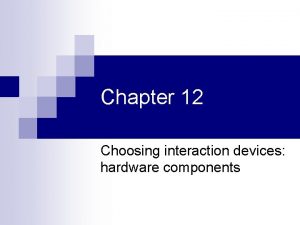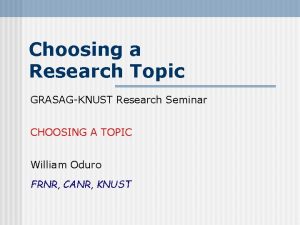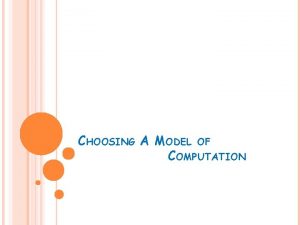HARDWARE COMPONENTS Choosing the hardware components for a






































- Slides: 38

HARDWARE COMPONENTS: Choosing the hardware components for a wireless sensor node has to consider size, costs, and energy consumption of the nodes. A basic sensor node contains five main components such as Controller, Memory, Sensors and Actuators, Communication devices and Power supply Unit. NAVEEN RAJA. V SINGLE-NODE ARCHITECTURE 1 Sensor node Hardware components

Ø Controller: It collects data from the sensors, processes this data, decides when and where to send it, similarly receives data from other sensor nodes and decides on the actuator’s behavior. It has to execute various programs, hence it is the Central Processing Unit (CPU) of the node. For General-purpose processors applications microcontrollers are used. These are highly overpowered, and their energy consumption is excessive. These are used in embedded systems. NAVEEN RAJA. V The controller is the core of a wireless sensor node, it process all the relevant data, capable of executing arbitrary code. 2

Ø Controller: cntd…. A Programmable Digital Signal Processor (P-DSP) is a specialized Microprocessors with its architecture optimized for the operational needs of Digital Signal Processor. The goal of DSPs is usually to measure, filter and/or compress continuous real-world analog signals. In a wireless sensor node, such a DSP could be used to process data coming from a simple analog wireless communication device to extract a digital data stream. In broadband wireless communication, DSPs are an appropriate and successfully used platform NAVEEN RAJA. V The characteristics of microcontrollers are best suited to embedded systems and have flexibility in connecting with sensors because they have memory built in. 3

Ø Controller: cntd…. An Field Programmable Gate Array (FPGA) can be reprogrammed “in the field” to adapt to a changing set of requirements, this can take time and energy. ASIC has a specialized testing methods, so it may increase cost and effort. NAVEEN RAJA. V An Application Specific Integrated Circuit (ASIC) is a specialized processor, custom designed for a given application only. Examples: Intel Strong ARM, Texas Instruments MSP 430, Atmel ATmega. 4

Ø Memory: Memory is required to store programs and intermediate data; usually, different types of memory are used for programs and data. RAM is fast, its main disadvantage is that it loses its content if power supply is interrupted. Program code can be stored in Read-Only Memory (ROM) or in Electrically Erasable Programmable Read-Only Memory (EEPROM) or flash memory. NAVEEN RAJA. V In WSN there is a need for Random Access Memory (RAM) to store intermediate sensor readings, packets from other nodes, and so on. Flash memory is similar to EEPROM but allowing data to be erased or written in blocks instead of only a byte at a time. 5 It can also serve as intermediate storage of data in case RAM is insufficient or the power supply of RAM should be shut down.

Ø Sensors and actuators: Sensors can be roughly categorized into three categories as Passive omnidirectional sensors: These sensors can measure a physical quantity at the point of the sensor node without actually manipulating the environment by active probing. Passive narrow-beam sensors: These sensors are passive as well, but have a well-defined notion/idea of direction of measurement. Active sensors: These actively analyses the environment. For example, a radar sensor or some types of seismic sensors, which generate shock waves by small explosions. Actuators: Actuators are just about as diverse as sensors, yet for the purposes of designing a WSN that converts electrical signals into physical phenomenon. NAVEEN RAJA. V The actual interface to the physical world: The devices that can observe or control physical parameters of the environment. 6

Ø Communication Device: To turn nodes into a network a device is required for sending and receiving information over a wireless channel. In some cases, wired communication can actually be the method of choice and is frequently applied in many sensor networks. The case of wireless communication is considerably more interesting because it include radio frequencies. Radio Frequency (RF)-based communication is by far the most relevant one as it best fits the requirements of most WSN applications. NAVEEN RAJA. V Transmission medium selection: The communication device is used to exchange data between individual nodes. 7

Ø Communication Device: …cntd Transceivers: For Communication, both transmitter and receiver are required in a sensor node to convert a bit stream coming from a microcontroller and convert them to and from radio waves. Transceiver structure has two parts as Radio Frequency (RF) front end and the baseband part. The radio frequency front end performs analog signal processing in the actual radio frequency Band. The baseband processor performs all signal processing in the digital domain and communicates with a sensor node’s processor or other digital circuitry. NAVEEN RAJA. V For two tasks a combined device called transceiver is used. 8

Ø Communication Device: …cntd § The Power Amplifier (PA) accepts signals from the IF or baseband part and amplifies them for transmission over the antenna. § The Low Noise Amplifier (LNA) amplifies incoming signals up to levels suitable for further processing without significantly reducing the SNR. § Elements like local oscillators or voltage-controlled oscillators and mixers are used for frequency conversion from the RF spectrum to intermediate frequencies or to the baseband. NAVEEN RAJA. V Transceivers: RF Front end structure 9 RF Front end structure

Ø Communication Device: …cntd Transceiver tasks and characteristics: § Power consumption and energy efficiency: The energy required to transmit and receive a single bit. § Carrier frequency and multiple channels: § State change times and energy: A transceiver can operate in different modes as sending or receiving, use different channels, or be in different power-safe states. § Data rates: Carrier frequency and used bandwidth together with modulation and coding determine the gross data rate. § Modulations: The transceivers typically support one or several of on/off-keying, ASK, FSK, or similar modulations. § Coding: Some transceivers allow various coding schemes to be selected. NAVEEN RAJA. V § Service to upper layer: A receiver has to offer certain services to the upper layers, mostly to the Medium Access Control (MAC) layer. Sometimes, this service is packet oriented or a transceiver only provides a byte interface or even only a bit interface to the microcontroller. 10

NAVEEN RAJA. V 11

Transceiver tasks and characteristics: § Range: The range is considered in absence of interference; it evidently depends on the maximum transmission power, on the antenna characteristics. § Blocking performance: The blocking performance of a receiver is its achieved bit error rate in the presence of an interferer. § Out of band emission: The inverse to adjacent channel suppression is the out of band emission of a transmitter. § Carrier sense and RSSI: In MAC protocols, sensing through wireless channel, the carrier, is busy that another node is transmitting then the signal strength at which an incoming data packet has been received can provide in the Received Signal Strength Indicator (RSSI). § Frequency stability: The degree of variation from minimal center frequencies when environmental conditions of oscillators like temperature or pressure change. § Voltage range: Transceivers should operate reliably over a range of supply voltages. NAVEEN RAJA. V Ø Communication Device: …cntd 12

As usually no tied power supply is available, some form of batteries are necessary to provide energy. Sometimes, some form of recharging by obtaining energy from the environment is available as well (e. g. solar cells). There are essentially two features: 1. Storing energy 2. Energy scavenging Storing energy: Batteries Traditional batteries: The power source of a sensor node is a battery, either non-rechargeable(primary) or rechargeable(secondary). Upon these batteries the requirements are • • • Capacity: . Capacity under load: Self-discharge: Efficient recharging: Relaxation: DC–DC Conversion: Unfortunately, batteries alone are not sufficient as a direct power source for a sensor node. A DC – DC converter can be used to overcome this problem by regulating the voltage delivered to the node’s circuitry NAVEEN RAJA. V Ø Power supply: 13

Ø Power supply: …. . cntd § For this energy scavenging is used which is the process of recharging the battery with energy gathered from the environment like solar cells or vibration-based power generation. Photovoltaics: The well-known solar cells can be used to power sensor nodes. Temperature gradients: Differences in temperature can be directly converted to electrical energy. NAVEEN RAJA. V Energy scavenging: § Depending on application, high capacity batteries that last for long times with negligible self-discharge rate, and that can efficiently provide small amounts of current. Vibrations: General form of mechanical energy is vibrations. Flow of air/liquid: Another often-used power source is the flow of air or liquid in wind mills or turbines. The challenge here is again the miniaturization, but some of the work on millimeter scale MEMS gas turbines might be reusable. 14

Ø ENERGY CONSUMPTION OF SENSOR NODES: The main consumers of energy are the controller, the radio front ends, the memory, and type of the sensors. There are two methods to reduce power consumption of these components: 1. Designing low-power chips is efficient for sensor nodes. But the limitation is the benefit gained by such designs can easily be wasted when the components are improperly operated. 2. Reduced functionality by using multiple states of operation with reduced energy consumption. NAVEEN RAJA. V Energy is supplied to a sensor node through batteries(have small capacity) and recharging by energy scavenging(complicated and volatile). Hence, the energy consumption of a sensor node must be tightly controlled. 15

Ø ENERGY CONSUMPTION OF SENSOR NODES: …. . cntd Microcontroller energy consumption: For a controller, typical states are “active”, “idle”, and “sleep”. § The energy saving in microcontroller is denoted given by Esaved =(tevent − t 1)Pactive − (τdown (Pactive + Psleep)/2 +(tevent − t 1 − τdown )Psleep) Eoverhead = τUp (Pactive + Psleep)/2 Examples: Intel Strong. ARM: In normal mode the power consumption is up to 400 m. W. In idle mode the power consumption is up to 100 m. W. In sleep mode the power consumption is up to 50 μW. Texas Instruments MSP 430: In fully operational mode it consumes 1. 2 m. W In the deepest sleep mode(LPM 4) only consumes 0. 3 μW. In the next 3 higher modes consumes only 6 μW. Atmel ATmega In Atmel ATmega power consumption varies between 6 m. W and 15 m. W in idle and active modes and is about 75 μW in power-down modes. Note: Power is energy divided by time. Often units of J/s (joules/second). Gives as Watts. NAVEEN RAJA. V § The energy overhead is denoted by 16

Ø ENERGY CONSUMPTION OF SENSOR NODES: …. . cntd Memory energy consumption: Off-chip RAM is rarely used. In fact, the power needed to drive on-chip memory is usually included in the power consumption numbers given for the controllers. Hence, the most relevant part is FLASH memory. Energy consumption necessary for reading and writing to the Flash memory is used on the Mica nodes. Hence, writing to FLASH memory can be a time and energy consuming task that is best avoided if somehow possible. NAVEEN RAJA. V The most relevant kinds of memory are on-chip memory and FLASH memory. 17

Ø ENERGY CONSUMPTION OF SENSOR NODES: …. . cntd To maintain low energy consumption, the transceivers should be turned off most of the time and only be activated when Necessary. The energy consumed by a transmitter is due to RF signal generation (depends on Modulation & target distance) and due to electronic components necessary for frequency synthesis, frequency conversion, filters, and so on. Similar to the transmitter, the receiver can be either turned off or turned on. NAVEEN RAJA. V Radio transceivers energy consumption: A radio transceiver has essentially two tasks as transmitting and receiving data between a pair of nodes. 18

Ø ENERGY CONSUMPTION OF SENSOR NODES: …. . cntd Power consumption of sensor and actuators: For example, passive light or temperature sensors – the power consumption can possibly be ignored in comparison to other devices on a wireless node. For other active devices like sonar (A measuring instrument that sends out an acoustic pulse in water and measures distances in terms of time for the echo of the pulse to return), power consumption can be quite considerable in the dimensioning of power sources on the sensor node, not to overstress batteries. NAVEEN RAJA. V Providing guidelines about the power consumption of the actual sensors and actuators is impossible because of the wide variety of these devices. 19

Ø OPERATING SYSTEMS AND EXECUTION ENVIRONMENTS: An embedded system is some combination of computer hardware and software, either fixed in capability or programmable, that is specifically designed for a particular function. Embedded operating systems (EOS) are designed to be used in embedded computer systems. EOS are able to operate with a limited number of resources. They are very compact and extremely efficient by design NAVEEN RAJA. V Embedded operating systems: An operating system (OS) is system software that manages computer hardware and software resources i. e acts as an intermediary between programs and the computer hardware. 20

WSN consists of a large number of tiny and low-power nodes, each of which executes simultaneous and reactive programs that must work with strict memory and power constraints. Tiny. OS meets these challenges. Salient features of Tiny. OS are § Has Event-based concurrency model § Component-based architecture. § Tiny. OS’s component library includes network protocols, distributed services, sensor drivers, and data acquisition tools. § Tiny. OS’s event-driven execution model NAVEEN RAJA. V Ø OPERATING SYSTEMS AND EXECUTION ENVIRONMENTS: Tiny. OS is an open-source, flexible and Application-Specific Operating System for wireless sensor networks. 21

Ø Concurrent Programming: Concurrent processing is a computing model in which multiple processors execute instructions simultaneously for better performance. It is said to be synonymous with parallel processing. Tasks are broken down into subtasks that are then assigned to separate processors to perform simultaneously. Ø Process-based concurrency: It is concurrent (parallel) execution of multiple processes on a single CPU. Fault-tolerance and scalability is the main advantages of using processes. It has advantage compared with thread that if they can crash and we can retrieve process perfectly by just restarting them. But if thread crashes, it may crash the entire process. NAVEEN RAJA. V Ø OPERATING SYSTEMS AND EXECUTION ENVIRONMENTS: Programming paradigms and application programming interfaces: 22

Ø OPERATING SYSTEMS AND EXECUTION ENVIRONMENTS: …Cntd Ø Event-based programming: In Event-driven programming the flow of the program is determined by events such as user actions (mouse clicks, key presses), sensor outputs, or messages from other programs/threads. Event-driven programming is the leading paradigm used in Graphical User Interfaces (GUI-type of user interface that allows users to interact with electronic devices through graphical icons). Interfaces to the operating system: It is a boundary across which two independent systems meet and act or communicate with each other. User interface - the keyboard, mouse, menus of a computer system. Application Programming Interface is a user interface allows the user to communicate with the OS. It is a set of commands, functions, protocols, and objects (wireless links, nodes) that programmers can use to interact with an external system (sensors, actuators, transceivers). NAVEEN RAJA. V Programming paradigms/ standards and application programming interfaces: 23

Layering is the traditional approach to communication protocol structuring. Individual protocols are stacked on top of each other, each layer only using functions of the layer directly. This layered approach has great benefits in keeping the entire protocol stack manageable, in containing complexity, and in promoting modularity and reuse. But it is not clear whether such a strictly layered approach will serve for WSN. A protocol stack refers to a group of protocols that are running concurrently that are employed for the implementation of network protocol suite. The protocols in a stack determine the interconnectivity rules for a layered network model such as in the OSI or TCP/IP models. NAVEEN RAJA. V Ø STRUCTURE OF OS AND PROTOCOL STACK: 24

Ø DYNAMIC ENERGY AND POWER MANAGEMENT: Dynamic Power Management (DPM) on a system level is the problem because it requires energy and time for the transition of a component between any two states. It should me controlled by operating system, by the protocol stack to operate with the lowest power consumption as possible. NAVEEN RAJA. V Switching individual components into various sleep states or reducing their performance by scaling down frequency and supply voltage and selecting particular modulation and coding are prominent examples for improving energy efficiency. 25

NETWORK ARCHITECTURE: Ø Sensor network scenarios: § Types of sources and sinks: Source is any unit in the network that can provide information(sensor node). A sink is the unit where information is required, it could belong to the sensor network or outside this network to interact with the another network or a gateway to another larger Internet. NAVEEN RAJA. V This concept has discussion on turning individual sensor nodes into a wireless sensor network and Optimization goals of how a network should function. Sensor network scenarios Optimization goals and figures of merit Gateway concepts 26 Three types of sinks in a very simple, single-hop sensor network

Ø Sensor network scenarios: …. cntd Multi-hop networks: As direct communication is impossible because of distance and/or obstacles § Multiple sinks and sources: In many cases, multiple sources and multiple sinks present. Multiple sources should send information to multiple sinks. Either all or some of the information has to reach all or some of the sinks. NAVEEN RAJA. V § Single-hop versus multi-hop networks: Because of limited distance the direct communication between source and sink is not always possible. In WSNs, to cover a lot of environment The data packets taking multi hops from source to the sink. Multi-hopping improves the energy efficiency of communication as it consumes less energy to use relays instead of direct communication. 27

Ø Sensor network scenarios: …. cntd NAVEEN RAJA. V § Multiple sinks and sources: Multiple sources and/or multiple sinks 28

Ø Sensor network scenarios: Three types of mobility: In wireless communication has to support mobile participants. In WSN, mobility can appear in three main forms…. Node mobility: The wireless sensor nodes themselves can be mobile Sink mobility: The information sinks can be mobile. Event mobility: The objects to be tracked can be mobile. NAVEEN RAJA. V § o o o …. cntd Sink mobility: A mobile sink moves through a sensor network as information is being retrieved on its behalf 29

Ø Sensor network scenarios: …. cntd NAVEEN RAJA. V § Three types of mobility: o Event mobility: The objects to be tracked can be mobile. Event mobility: An event(elephant) moves through the network along with the event source (dashed line) 30

Ø Optimization goals and figures of merit: Quality of service Energy efficiency Scalability Robustness Quality of service: WSNs differ from other conventional communication networks in the type of service they offer. These networks essentially only move bits from one place to another. NAVEEN RAJA. V For all WSN scenarios and application types have to face the challenges such as • How to optimize a network and How to compare these solutions? • How to decide which approach is better? • How to turn relatively inaccurate optimization goals into measurable figures of merit? For all the above questions the general answer is obtained from 31

Ø Optimization goals and figures of merit: …. cntd Quality of service: Some generic possibilities are Event detection/reporting probability Event classification error- If events are not only to be detected but also to be classified, the error in classification must be small Approximation accuracy- For function approximation applications, the average/maximum absolute or relative error with respect to the actual function. NAVEEN RAJA. V Event detection delay -It is the delay between detecting an event and reporting it to any/all interested sinks Tracking accuracy Tracking applications must not miss an object to be tracked, the reported position should be as close to the real position as possible, and the error should be small. 32 Missing reports -In applications that require periodic reporting, the probability of undelivered reports should be small

Ø Optimization goals and figures of merit: …. cntd Scalability: The ability to maintain performance characteristics irrespective of the size of the network is referred to as scalability. The need for extreme scalability has direct consequences for the protocol design Often, a penalty in performance or complexity has to be paid for small networks Architectures and protocols should implement appropriate scalability support rather than trying to be as scalable as possible Applications with a few dozen nodes might admit more-efficient solutions than applications with thousands of nodes NAVEEN RAJA. V With WSN potentially consisting of thousands of nodes, scalability is an obviously essential requirement 33

Ø Optimization goals and figures of merit: Robustness: …. cntd They should not fail just because a limited number of nodes run out of energy, or because their environment changes and severs existing radio links between two nodes If possible, these failures have to be compensated by finding other routes. NAVEEN RAJA. V Wireless sensor networks should also exhibit an appropriate robustness 34

Ø Optimization goals and figures of merit: Robustness: …. cntd They should not fail just because a limited number of nodes run out of energy, or because their environment changes and severs existing radio links between two nodes If possible, these failures have to be compensated by finding other routes. NAVEEN RAJA. V Wireless sensor networks should also exhibit an appropriate robustness 35

Ø Gate way concepts Need for gateways The network rather has to be able to interact with other information devices for example to read the temperature sensors in one’s home while traveling and accessing the Internet via a wireless. Wireless sensor networks should also exhibit an appropriate robustness They should not fail just because of a limited number of nodes run out of energy or because of their environment changes and breaks existing radio links between two nodes If possible, these failures have to be compensated by finding other routes. NAVEEN RAJA. V For practical deployment, a sensor network only concerned with itself is insufficient. 36

Ø Gate way concepts WSN to Internet communication: NAVEEN RAJA. V Internet to WSN communication 37

Ø Gate way concepts NAVEEN RAJA. V WSN tunneling: The gateways can also act as simple extensions of one WSN to another WSN. The idea is to build a larger using “tunneling” all protocol messages between two WSNetworks and simply using the Internet as a transport network. Connecting two WSNs with a tunnel over the Internet 38
 Internal hardware and external hardware
Internal hardware and external hardware Egg för emanuel
Egg för emanuel Tobinskatten för och nackdelar
Tobinskatten för och nackdelar Atmosfr
Atmosfr Meios steg för steg
Meios steg för steg Verifikationsplan
Verifikationsplan Personlig tidbok
Personlig tidbok Rutin för avvikelsehantering
Rutin för avvikelsehantering Myndigheten för delaktighet
Myndigheten för delaktighet Presentera för publik crossboss
Presentera för publik crossboss Fuktmätningar i betong enlig rbk
Fuktmätningar i betong enlig rbk Fspos
Fspos Kung som dog 1611
Kung som dog 1611 Tack för att ni har lyssnat
Tack för att ni har lyssnat Boverket ka
Boverket ka Referatmarkering
Referatmarkering Varför kallas perioden 1918-1939 för mellankrigstiden
Varför kallas perioden 1918-1939 för mellankrigstiden Brant karttecken
Brant karttecken Fimbrietratt
Fimbrietratt Lufttryck formel
Lufttryck formel Tallinjen
Tallinjen Elektronik för barn
Elektronik för barn Borra hål för knoppar
Borra hål för knoppar Bris för vuxna
Bris för vuxna Mat för unga idrottare
Mat för unga idrottare A gastrica
A gastrica Smärtskolan kunskap för livet
Smärtskolan kunskap för livet Trög för kemist
Trög för kemist Vad är ett minoritetsspråk
Vad är ett minoritetsspråk Etik och ledarskap etisk kod för chefer
Etik och ledarskap etisk kod för chefer Typiska novell drag
Typiska novell drag Indikation för kejsarsnitt på moderns önskan
Indikation för kejsarsnitt på moderns önskan Steg för steg rita
Steg för steg rita Toppslätskivling effekt
Toppslätskivling effekt Debatt mall
Debatt mall Redogör för vad psykologi är
Redogör för vad psykologi är Bästa kameran för astrofoto
Bästa kameran för astrofoto En lathund för arbete med kontinuitetshantering
En lathund för arbete med kontinuitetshantering Lek med former i förskolan
Lek med former i förskolan






























































